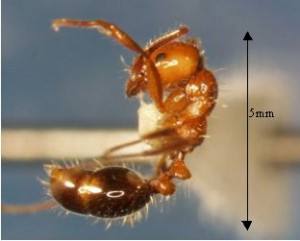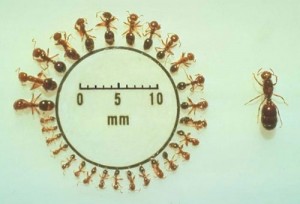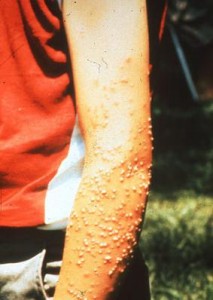
 Fire ants, native to South America, were discovered in Brisbane in February 2001. The National Fire Ant Eradication Program, led by Biosecurity Queensland, has been using the latest research and techniques to significantly reduce fire ant numbers since the program began in September 2001.
Fire ants, native to South America, were discovered in Brisbane in February 2001. The National Fire Ant Eradication Program, led by Biosecurity Queensland, has been using the latest research and techniques to significantly reduce fire ant numbers since the program began in September 2001.
Fire ant facts
- Fire ants inflict a painful sting, followed by itchy pustules, which can take months to heal
- Destroy the environment
- Impact on agricultural production, mainly by destroying seeds
- Threaten our outdoor lifestyle and stop children from playing safely in backyards and parks
- Have caused many deaths and thousands of people to be hospitalised with allergic reactions in the USA
- Kill young animals in the wild, often at birth
 Fire ants could cost Australia around $43 billion over the next 30 years is they are not managed and eradicated.
Fire ants could cost Australia around $43 billion over the next 30 years is they are not managed and eradicated.
What do fire ants look like?
Fire ants are
- Small, ranging in size from 2 to 6mm
- Found in a variety of sizes within each nest
- Coppery-brown with a darker abdomen
- Aggressive when their nest is disturbed
 Fire ant nests
Fire ant nests
- Are various shapes and sizes
- Are up to 40cm high
- Usually have no visible entry or exit hole
- Have a honeycomb-like internal structure
- Can be built around other structures, such as posts, logs, stones and piles of wood
What should you do?
If you suspect you have fire ants
- All Biosecurity Queensland on 13 25 23
- Never touch the ants or their nest
- Never try to treat or remove the nest yourself
- Never move high-risk, potentially infected items off your property
IMPORTANT: Never treat a suspected fire ant nest. Correct identification is essential, as ants or a nest may not be fire ants, and killing the wrong type of ants may be harmful to an ecosystem or environment.
 If you bitten by fire ants
If you bitten by fire ants
- Apply a cold compress to relieve the swelling and pain
- Gently wash the affected area with soap and water, and leave the blister intact
- Then seek medical attention, ESPECIALLY IF YOU ARE ALLERGIC TO INSECT STINGS AND BITES!
How can you help?
- Regularly check your property (including residential and business) and report any suspected ants or nests
- If you live or work in a fire ant restricted, check with Biosecurity Queensland before moving high-risk items such as: soil, sand and similar products, mulch and compost, pot plants and potting mixes, baled hay and straw, landscaping and construction materials, earthmoving machinery and equipment, and material that has been in contact with the ground for an extended period of time
- Before excavating your property, arrange for a free Biosecurity Queensland site inspection
- When purchasing high-risk items, ask your supplier or service provider if the product is fire ant free
- Become a fire ant volunteer ranger and help minimise the treat of fire ants to your community
More information
Maps of fire ant restricted areas can be viewed at libraries, the Biosecurity Queensland Control Centre, local, state and federal government electoral offices, and the Biosecurity Queensland website.
Phone 13 25 23 or visit www.biosecurity.qld.gov.au
